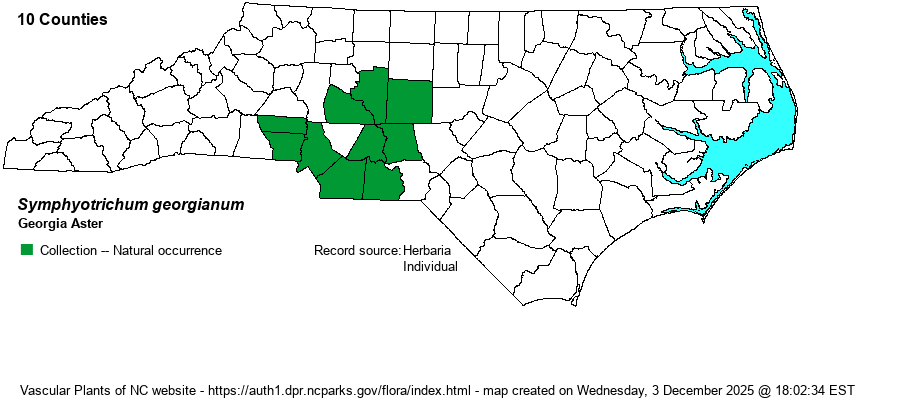| Author | (Alexander) G.L. Nesom | |
| Distribution | Southern and central Piedmont only. Records from counties other than those shown on the map below are misidentifications of S. patens or S. phlogifolium.
Piedmont and low Mountains of NC, SC, GA, and AL. Disjunct to southwestern GA and northern FL. | |
| Abundance | Uncommon to locally common. The NCNHP database has about 80 records. The species was considered a part of S. patens a few decades ago and was simply not paid attention to, but upon description about 30 years ago, botanists and other biologists have found many populations, and it is not a rare plant in NC. Though it is State Threatened and a Candidate for Federal listing, it is numerous enough -- State Rank of S3 -- that these statuses are not needed now. | |
| Habitat | Dry oak-hickory-Red Cedar woodlands and openings, glades, roadsides, and powerlines through such habitats. It is assumed that this species originally occurred in fire-prone, thin soil, in slightly mafic to lightly acidic habitats; however, it is not a species thought of as a "mafic" species, such as S. concinnum or S. laeve. | |
| Phenology | Flowering and fruiting October - mid-November. | |
| Identification | This species is easily confused with the widespread S. patens, but Georgia Aster is colonial from horizontal rhizomes, middle and upper leaves are sessile but not strongly clasping the stem (vs. clasping with leaf tissue around most or all of the stem), has longer and more violet or purple-colored rays (vs. more bluish), and white disk florets (vs. yellow). From S. phlogifolium it differs in its colonial habit, less clasping leaves, thicker textured leaves (vs. thin or soft), and smaller upper stem leaves (maximum of 2 inches vs. 3 inches or more). Georgia Aster is a quite beautiful plant in bloom, with richer or deeper violet rays than seen on nearly all other asters; and with the white disk, the violet-white contrast is distinctive. | |
| Taxonomic Comments | NOTE: The genus Aster was examined by G.L. Nesom (1994), who determined that it was composed of a number of discrete genera (a few of which were already split off by authors as Sericocarpus, Ionactis, etc.). The earliest available name for North American "Aster" is Symphyotrichum, a name regrettably long and hard to spell.
It had been included within S. patens when RAB (1968) and other old references were published.
| |
| Other Common Name(s) | None | |
| State Rank | S3 | |
| Global Rank | G3 | |
| State Status | T | |
| US Status | C | |
| USACE-agcp | | |
| USACE-emp | | |

